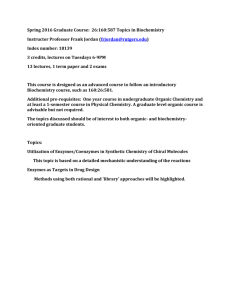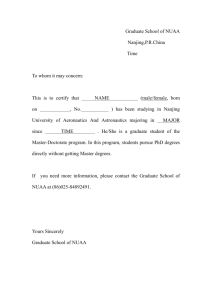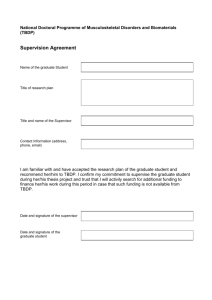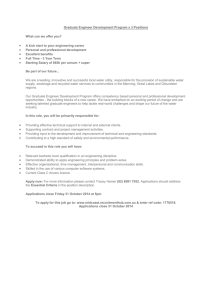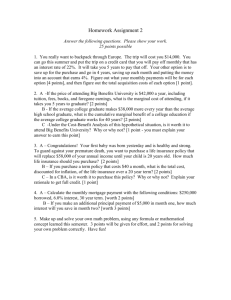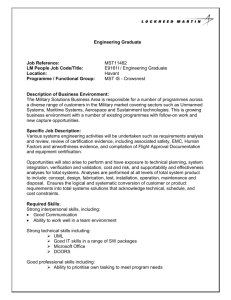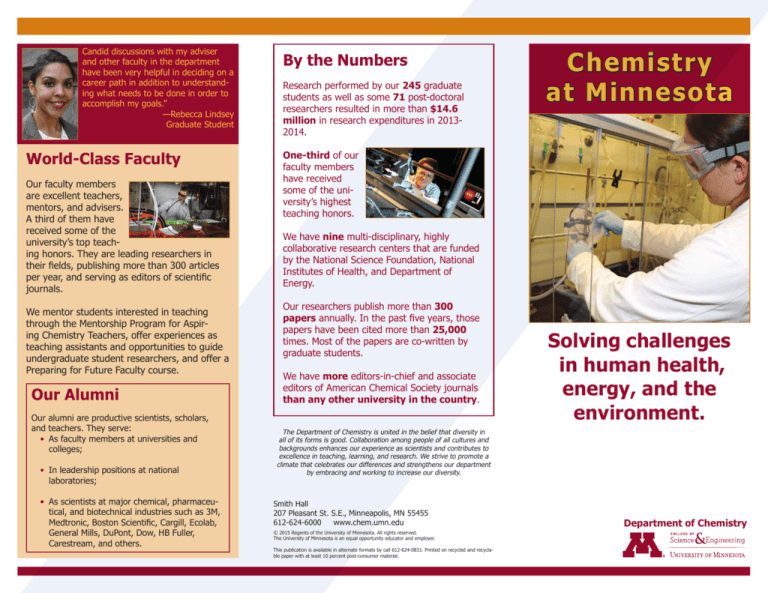
Candid discussions with my adviser
and other faculty in the department
have been very helpful in deciding on a
career path in addition to understanding what needs to be done in order to
accomplish my goals.”
—Rebecca Lindsey
Graduate Student
World-Class Faculty
Our faculty members
are excellent teachers,
mentors, and advisers.
A third of them have
received some of the
university’s top teaching honors. They are leading researchers in
their fields, publishing more than 300 articles
per year, and serving as editors of scientific
journals.
We mentor students interested in teaching
through the Mentorship Program for Aspiring Chemistry Teachers, offer experiences as
teaching assistants and opportunities to guide
undergraduate student researchers, and offer a
Preparing for Future Faculty course.
Our Alumni
Our alumni are productive scientists, scholars,
and teachers. They serve:
• As faculty members at universities and
colleges;
• In leadership positions at national
laboratories;
• As scientists at major chemical, pharmaceutical, and biotechnical industries such as 3M,
Medtronic, Boston Scientific, Cargill, Ecolab,
General Mills, DuPont, Dow, HB Fuller,
Carestream, and others.
By the Numbers
Research performed by our 245 graduate
students as well as some 71 post-doctoral
researchers resulted in more than $14.6
million in research expenditures in 20132014.
Chemistry
at Minnesota
One-third of our
faculty members
have received
some of the university’s highest
teaching honors.
We have nine multi-disciplinary, highly
collaborative research centers that are funded
by the National Science Foundation, National
Institutes of Health, and Department of
Energy.
Our researchers publish more than 300
papers annually. In the past five years, those
papers have been cited more than 25,000
times. Most of the papers are co-written by
graduate students.
We have more editors-in-chief and associate
editors of American Chemical Society journals
than any other university in the country.
Solving challenges
in human health,
energy, and the
environment.
The Department of Chemistry is united in the belief that diversity in
all of its forms is good. Collaboration among people of all cultures and
backgrounds enhances our experience as scientists and contributes to
excellence in teaching, learning, and research. We strive to promote a
climate that celebrates our differences and strengthens our department
by embracing and working to increase our diversity.
Smith Hall
207 Pleasant St. S.E., Minneapolis, MN 55455
612-624-6000
www.chem.umn.edu
© 2015 Regents of the University of Minnesota. All rights reserved.
The University of Minnesota is an equal opportunity educator and employer.
This publication is available in alternate formats by call 612-624-0831. Printed on recycled and recyclable paper with at least 10 percent post-consumer material.
Department of Chemistry
Research Opportunities
Working with some of the top chemists in their fields,
you will be actively engaged in research aimed at solving
some of society’s most important environmental, health,
and energy issues.
“The number one lesson I’ll take away
from graduate school is how important
cross-disciplinary collaboration and effective team management is for solving
problems efficiently.”
—Stephen Rudisill
graduate student
Research is concentrated into several foci: chemical biology, chemical physics, chemical theory and computation,
energy and catalysis, and environmental and green, analytical and bioanalytical, experimental physical, inorganic and organometallic, nanoscience and materials, organic, and
polymer chemistry.
There are opportunities to participate in nine multi-disciplinary, collaborative research
centers that are funded by the National Institutes of Health, Department of Energy, and
National Science Foundation: Center for Metals in Biocatalysis, Center for Sustainable
Polymers, Center for Analysis of Biomolecular Signaling, Inorganometallic Catalyst
Design Center, Chemical Theory Center, Nanoporous Materials Genome Center, Scientific
Discovery through Advanced Computing (SciDAC) Partnership for Charge Transfer and
Charge Transport in Photoactivated Systems, Center for Sustainable Nanotechnology;
Materials Research Science and Engineering Center, and Industrial Partnership for
Research in Interfacial & Materials Engineering.
As a researcher, you will:
Conduct medical, pharmaceutical, and materials research in collaboration with Minnesota’s world-class medical school, which is located across the street, and with the university’s top-ranked science and engineering programs. There are opportunities to work with
hundreds of Minneapolis-area healthcare organizations and medical device companies,
including several Fortune 500 companies.
Watch our videos www.chem.umn.edu
Have access to state-of-the-art
equipment and technology needed
for leading-edge chemistry research: the department’s nuclear
magnetic resonance, mass spectrometry and X-ray crystallographic
laboratories, the university’s Materials Characterization, Nanofabrication and Polymer Synthesis facilities,
and the topnotch Minnesota Supercomputing Institute.
Share your research as authors of papers published in
prestigious scientific journals and at conferences and
poster sessions.
Empowerment
Our students gain experiences that extend beyond
the classroom and the
laboratory. We empower
our students to create an
environment where they can
prosper and contribute to their own learning, and
participate in a variety of leadership and outreach
activities:
• Joint Safety Team, a national award-winning
group led by graduate students and post-doctoral associates serving as laboratory safety
officers, pioneering innovative approaches to
improving safety in research laboratories and
our culture of safety;
• Community of Chemistry Graduate Students,
fostering graduate students working together
to support each other by offering workshops,
programs, and social and athletic events;
• Graduate Student Workshop Committee, organizing workshops on a variety of topics important to graduate students such as preparing for
oral exams, writing fellowship proposals, and
applying for jobs;
• Graduate Student Seminar Committee, selecting, inviting and hosting seminar speakers;
• Chemistry WISE, a networking resource for
women graduate students and post-doctorate
researchers, working to increase the recruitment and retention of women, and improving
the climate for all chemists; and
• Outreach Activities, engaging
future chemists via Cool Chemistry, Energy and U, Chemistsin-the Library, Chemists in the
Classroom, Minnesota State Fair,
University on the Prairie, and more.

